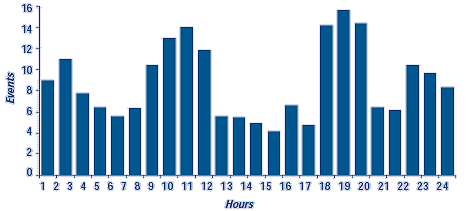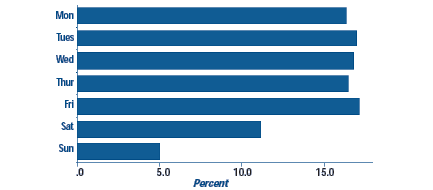
Center for Problem-Oriented Policing
Step 25: Pay attention to daily and weekly rhythms
Cycles of activities have tremendous influences on problems. The ebb and flow of vehicles caused by commuting and shopping rhythms, for example, changes the number of targets and guardians in parking facilities. This, in turn, influences when vehicle thefts and break-ins are most frequent. Robberies of drunken revelers may be more likely around bar closing time on Fridays and Saturdays, because the number of targets is higher. In this example, two important rhythms concentrate problem activities. The first is the workday/weekend cycle that makes Friday and Saturday nights so popular for entertainment and recreation. The second involves the daily cycle of opening and closing of bars. In this step we will discuss short-term fluctuations occurring over hours and days. In Step 26, we will look at longer time periods covering months and years.
Different facilities have different cycles of activities that can contribute to their associated problems. School rhythms are similar though distinct from job rhythms. Bus stops are influenced by the rhythm of commuting and shopping, but also by the more frequent coming and going of buses.
Charting the rhythm of crime or disorder events helps identify important activity cycles that may contribute to a problem. As shown in the figure below, calculate the average of the number of events occurring in each hour (or other time interval) over several days (data matrix at top), then plot the results (Chart A). Chart B shows the percentage of the week's events occurring on each day. Because some days routinely have very different rhythms than other days, Rachel Boba recommends charting days and hours together (Chart C). The result shows hot time periods throughout the week. Such charts are easy to produce; all three of these charts were created on a spreadsheet, using standard graphing routines.
Temporal analysis is easiest when problem events are frequent. So temporal analysis will be more useful for common minor events, like noise complaints and minor traffic accidents, than for uncommon serious events, like murder. If there are few events, then you can look at a longer period to collect more events. But if the problem changes in the longer period, the picture that emerges may be distorted or out of date.
Having reasonably exact times of occurrence helps temporal analysis. Contact crimes, such as robbery, rape, and assault, can be accurately pin-pointed as victims can often describe when these crimes took place. Property crimes, such as vehicle crimes, burglary, and vandalism, are much harder to pin down because victims usually provide only a time range during which such crimes could have occurred. Though it is common to use the midpoints in these ranges to estimate the times crimes occurred, this can lead to distortion and should be avoided for long periods (e.g., more than 8 hours).
Jerry Ratcliffe also has identified three forms of temporal clustering. First, events may be relatively evenly spread over the entire day. He calls this a diffused pattern. Second, focused patterns show clustering within distinct time ranges. Events clustered around rush hours follow focused patterns. Third, acute patterns are tightly packed within small periods. Disturbances immediately following bar closing time might be an example. Focused and acute patterns immediately suggest temporal cycles that should be investigated.
Though Ratcliffe developed his typology for daily patterns, the basic idea can be applied to weekly cycles. If no particular day of the week is routinely troublesome, this indicates a diffused weekly pattern. A cluster of days showing a marked increase in troublesome events indicates a focused pattern. Finally, if one or two days have a marked concentration of events, this indicates an acute pattern.
EXAMINING TEMPORAL RHYTHMS
A. Average Hourly Rhythm

B. Percent of Week's Events

C. Daily and Hourly Rhythms

Read More
- Boba, Rachel (2005). Crime Analysis and Crime Mapping: An Introduction. Thousand Oaks, CA: Sage Publications.